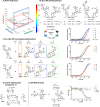Flexibility-tuning of dual-display DNA-encoded chemical libraries facilitates cyclic peptide ligand discovery
- PMID: 40188178
- PMCID: PMC11972359
- DOI: 10.1038/s41467-025-58507-w
Flexibility-tuning of dual-display DNA-encoded chemical libraries facilitates cyclic peptide ligand discovery
Abstract
Cyclic peptides constitute an important drug modality since they offer significant advantages over small molecules and macromolecules. However, access to diverse chemical sets of cyclic peptides is difficult on a large library scale. DNA-encoded Chemical Libraries (DELs) provide a suitable tool to obtain large chemical diversity, but cyclic DELs made by standard DEL implementation cannot efficiently explore their conformational diversity. On the other hand, dual-display Encoded Self-Assembling Chemical (ESAC) Libraries can be used for modulating macrocycle flexibility since the two displayed peptides can be connected in an incremental fashion. In this work, we construct a 56 million dual-display ESAC library using a two-step cyclization strategy. We show that varying the level of conformational restraint is essential for the discovery of specific ligands for the three protein targets thrombin, human alkaline phosphatase and streptavidin.
© 2025. The Author(s).
Conflict of interest statement
Competing interests: D.P., M.K., A.G. and J.S. are assignees of a patent application WO2022/084486. D.N. is co-founder and shareholder of Philochem AG ( http://www.philochem.com ), a company active in the field of DELs. The other authors declare no competing interests.
Figures





Similar articles
-
Encoded libraries of chemically modified peptides.Curr Opin Chem Biol. 2015 Jun;26:89-98. doi: 10.1016/j.cbpa.2015.02.008. Epub 2015 Mar 11. Curr Opin Chem Biol. 2015. PMID: 25768886 Review.
-
Proximity-driven site-specific cyclization of phage-displayed peptides.Nat Commun. 2024 Aug 24;15(1):7308. doi: 10.1038/s41467-024-51610-4. Nat Commun. 2024. PMID: 39181880 Free PMC article.
-
Opportunities for Expanding Encoded Chemical Diversification and Improving Hit Enrichment in mRNA-Displayed Peptide Libraries.Chembiochem. 2022 Jun 20;23(12):e202100685. doi: 10.1002/cbic.202100685. Epub 2022 Feb 18. Chembiochem. 2022. PMID: 35100479 Free PMC article. Review.
-
Small-molecule discovery through DNA-encoded libraries.Nat Rev Drug Discov. 2023 Sep;22(9):699-722. doi: 10.1038/s41573-023-00713-6. Epub 2023 Jun 16. Nat Rev Drug Discov. 2023. PMID: 37328653 Free PMC article. Review.
-
Encoded Display of Chemical Libraries on Nanoparticles as a Versatile Selection Tool To Discover Protein Ligands.J Am Chem Soc. 2025 Apr 9;147(14):11726-11740. doi: 10.1021/jacs.4c13487. Epub 2025 Feb 26. J Am Chem Soc. 2025. PMID: 40011448
Cited by
-
Influence of Macrocyclization Strategies on DNA-Encoded Cyclic Peptide Libraries.JACS Au. 2025 Jun 27;5(7):3399-3407. doi: 10.1021/jacsau.5c00473. eCollection 2025 Jul 28. JACS Au. 2025. PMID: 40747057 Free PMC article.
References
MeSH terms
Substances
LinkOut - more resources
Full Text Sources

